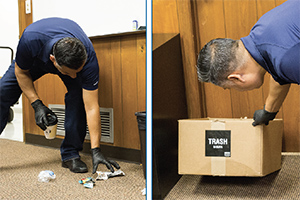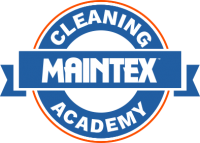Properly maintaining your facility’s carpeted areas on a daily basis will protect and extend the life of the carpet, enhance the appearance, and improve indoor air quality.
Instructions
Always wear personal protective equipment when handling chemicals. Review the product labels and chemical SDS. When using a secondary bottle it must be properly labeled.
Waste Collection
If occupants are present, announce yourself and make sure cleaning will not cause any disruption.

1
Pick up loose debris. Only dispose of boxes if they are marked as trash.

2
Empty all receptacles. Take the entire trash can to your cart. This ensures that bags do not leak on the floor.
TIP: Never compress trash with your hands or feet: there may be sharp objects that can cause injury.

3
Keep trash and recycling separate and use the correct liners for each.

4
When the liner is soiled, replace it with a fresh new liner.
TIP: If a liner is oversized, tie it off to prevent it from slipping down into the container.
Surface Dusting and Cleaning
Do not touch or move any personal belongings, including paperwork. Do not touch or clean computer equipment, as it can cause damage.

1
Wipe all horizontal surfaces using a duster or microfiber cloth. Start with high surfaces and work your way down.

2
Polish furniture by spraying furniture polish onto a clean cloth and wiping down the furniture. Be careful to avoid getting furniture polish onto floors as it can be a slipping hazard.

3
Clean windows, mirrors, and glass partitions by spraying them with glass cleaner and then wiping with a clean microfiber cloth.

4
Remove marks and scuffs on walls and other hard surfaces using a microfiber cloth dampened with a general purpose cleaner.

5
After all other cleaning is complete, sanitize shared surfaces by wiping them with pre-moistened disinfectant wipes or Turbo Kill applied to a clean microfiber cloth.
Daily Hard Floor Care
For carpet, follow the steps in the Maintex Daily Carpet Care training.

1
Place wet floor signs at the entrances.

2
Remove chairs and fixtures, pick up trash, then dust mop or sweep the floor.

3
Use a scraper to carefully remove any gum or sticky debris from the surface. Be careful to avoid gouging the floor.
Traditional Mop Method

1
Dilute neutral floor cleaner into a bucket and wringer with cold water according to label directions.

2
Immerse the mop in the cleaning solution and then lightly wring it out.

3
Mop the area using a figure-eight motion.

4
When your mop becomes dry, re-immerse it in the cleaning solution and lightly wring it out.

5
Replace the cleaning solution when it becomes dirty.

6
Make certain the floor is completely dry before removing Wet Floor signs.
Microfiber Mop Method

1
Dilute neutral floor cleaner into the solution bucket with cold water according to label directions. Place several mops into the solution to soak.

2
Remove one mop and attach it to the mop head.

3
Mop the area by walking in a straight line or using a figure-eight motion.

4
When your mop becomes soiled or starts to dry out, place it in the dirty bucket or a liner and replace it with a fresh mop from the solution bucket.

5
Make certain the floor is completely dry before removing Wet Floor signs.
Break Rooms and Common Areas
First, perform normal surface dusting and daily floor care.

1
Wipe countertops, tables, chairs and shelves with a clean microfiber cloth dampened with all-purpose cleaner.

2
Wipe the interior of refrigerators.

3
Unplug and clean the inside of microwaves, toasters, and toaster ovens. Plug the appliances back in after you are finished.
TIP: Food splatter and spills left unaddressed becomes more difficult to clean over time.

4
Clean sinks and water fountains by wiping with a microfiber cloth or sponge moistened with all purpose cleaner.

5
Spray stainless steel surfaces with oil-based stainless steel cleaner, then wipe with a microfiber cloth. Use a second cloth to polish the surface.
Sanitize Additional Touch Points
After you have finished all other cleaning, sanitize remaining touch points by wiping them with pre-moistened disinfectant wipes or Turbo Kill applied to a clean microfiber cloth.
This might include:

1
Door knobs

2
Light switches

3
Handrails and push bars

4
Elevator buttons

5
Water fountains
Finishing Up

1
If appropriate, turn off lights and lock doors.

2
Take collected waste to the designated collection point.

3
Return your cart to the cleaning supply closet. Place cleaning tools in their designated locations.

4
Check and empty vacuum bags.

5
Rinse used mops and hang them to dry, or place them in the laundry. Empty and rinse all buckets.
Knowledge Quiz
Test your comprehension by completing the knowledge quiz.
Launch Quiz
General Cleaning
General Cleaning
True or False: Effective general cleaning includes waste collection, surface dusting, daily floor care, cleaning common areas, sanitizing touch points, and restroom cleaning.
Thorough cleaning extends the life of property assets, improves appearance, and promotes health and wellness.
When emptying trash receptacles, you should...
Carry the entire trash receptacle to your cart to avoid leaks. Never remove items from receptacles or compress trash, as there may be sharp objects present. If the liner is soiled, replace it.
Which of the following surfaces should be dusted?
All of these should be dusted, as well as file cabinets and the tops of wall art. Remember not to touch or move personal belongings.
What is the correct method of applying furniture polish?
Spray furniture polish onto a clean cloth before applying it to furniture. Be careful to avoid getting furniture polish onto floors as it can be a slipping hazard.
True or False: You should clean computer screens by spraying with See Thru or another Maintex glass cleaner and then wiping with a microfiber glass cleaning cloth.
Do not touch computer equipment or clean it with chemicals, as this can cause damage.
Which of the following surfaces should be sanitized?
Properly sanitizing shared surfaces is critical for preventing germ cross-contamination and the spread of disease.
Which of the following steps should NOT be taken before mopping hard floor surfaces?
Before mopping, remove chairs and other obstacles, pick up trash and debris, dust mop the floor, and remove gum with a scraper. Dilute floor cleaner with cold water in a mop bucket - do not spray it directly onto the floor.
When cleaning common areas and break rooms, you should always remember to:
In addition to normal surface dusting and daily floor care, common areas require several additional steps. Be sure to plug the appliances back in after you are finished.
What is the proper method for cleaning stainless steel?
Spray stainless steel surfaces with Sta-Brite or another oil-based cleaner, wipe, and then polish with a second cloth. Never use strong abrasives on stainless steel.
When should sanitizing take place?
Properly sanitizing shared surfaces on a daily basis is critical for preventing germ cross-contamination and the spread of disease. After you have finished all other cleaning, sanitize remaining touch points.
General Cleaning
Featured Products
Surface dusting & Cleaning
Waste Collection
Daily floor care
Common Areas
Sanitization
Visit the Maintex online store to place your order any hour of the day or night







